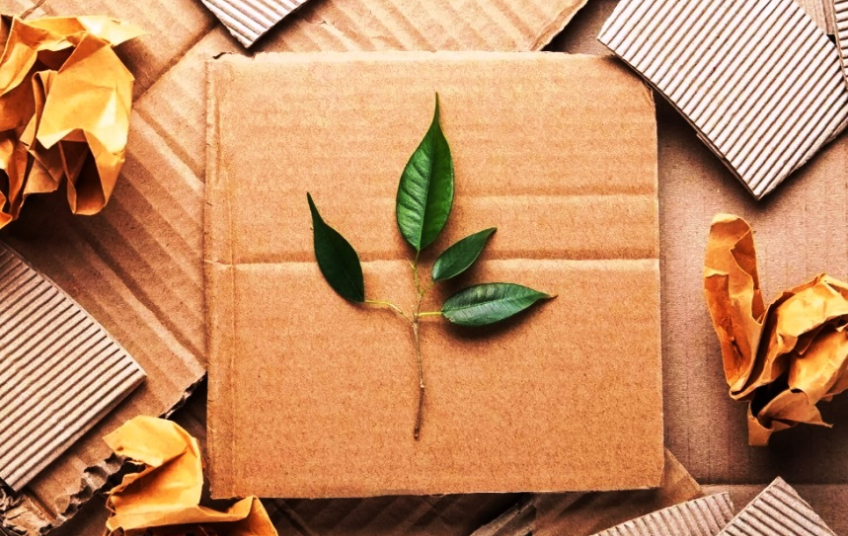As we all know, going into the new world, people are enthusiastic about recycling to help protect the planet from waste that harms the environment. This is because the waste thrown away may contain chemicals that can contaminate the air, water, and soil. In today’s world, about 29 percent of global waste comes from paper, cardboard, and plastic packaging. Fortunately, there has been an increase in ways to produce recyclable packaging. This enables manufacturers break down packaging products to turn them into new ones to avoid wasting that material and getting one step closer to a greener environment. To understand how recycling is better for the environment, it is best to know how certain materials can be broken down and reproduced into a new product for reuse. When hearing the word “packaging,” people mostly think of shipping boxes which as everyone knows, are made from corrugated cardboard. Luckily, all cardboard forms are recyclable and can be easily reused as a new product. Several steps go into recycling cardboard: shredding, pulped, filtered, dried, and made into new cardboard. Before the cardboard goes into the shredding process, it must be sorted depending on its configuration, such as boxboard or corrugated, because they are not produced the same way. This is crucial since they go through different processes and are made from other materials. Boxboard can be described as a single-layer box, such as cereal boxes or generally boxed foods, whereas corrugated cardboard is seen as single-walled, double-walled, or die-cut boxes, as seen in Figure 1 and Figure 2.
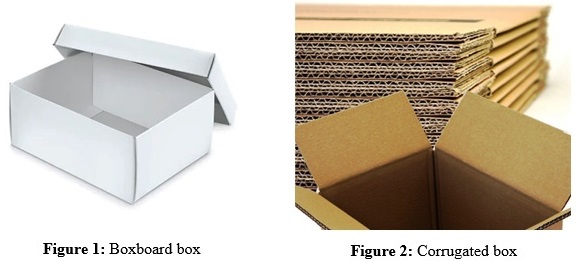
Once sorted, the cardboard goes through a shredding process where it is shredded into smaller pieces that will help throughout the reproduction process. After the shredding process, the cardboard is then mixed with water to break down the cardboard. This is done so that the cardboard can soften and, therefore, be able to make cardboard into a new product; this process is called “pulping.” After the pulping process, the cardboard pulp is then filtered out since the pulp is rarely 100 percent cardboard. Foreign materials like tape, ink, staples, and plastic can come from cardboard boxes for shipping or storage. This is done by using centrifugal systems to separate the different materials and is done so based on weight. Once filtered, the pulp is stored and left to set for a certain amount of time to make new cardboard.
When going back into the manufacturing process, more water is added to the pulp, then stirred and pressed to get the pulp to the right consistency for future use. This process could become very timely depending on the kind of configuration of the cardboard and the materials from which they will be made. After this, the pulp and water mixture must be rolled and dried; to do so, the mixture can contain no more than 90 percent of water. The rolled and dried process can be done in various ways, such as vacuum rollers, vibrating conveyor belts, and steam heating. This is done by pressing down and rolling the mixture into a sheet similar to paper that will later be used to produce a variety of new boxes or cardboard. The recycling process for cardboard can be simplified to the following diagram, as seen in Figure 3
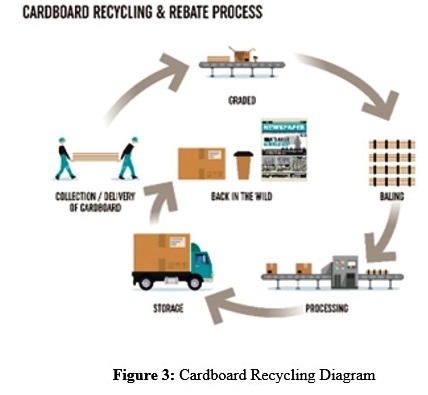
This is all done to reduce the waste from cardboard and paper. Recycling cardboard is better for the environment since cardboard would not be made from new materials and so would keep companies from cutting down trees to do so. This process would also be more cost-effective ranging from 25 to 50% of the saved cost. Along with being cost-effective, recycling helps preserve the natural resources of the planet since new products are being made from reused materials. As an extension, there would also be a significant energy conservation since producing new material from scratch consumes considerable energy. This will also help prevent discarding waste into landfills which will, in turn, help improve environmental sustainability and reduce the amount of pollution. In addition, this will also enhance the greenhouse effect caused by burning fossil fuels that are used in making new products that ultimately contribute to climate change.
Like paper and cardboard, plastic is another material commonly wasted instead of recycled, affecting environmental sustainability. Another similarity that plastic has with cardboard is that plastic is seen in all forms of packaging, including everything from foods to everyday objects. Today, only 9 percent of plastic waste is recycled meaning that the meaning waste is discarded in landfills, which causes harm to the environment. Luckily, technology has advanced over the years to where in the modern day. there are ways to recycle plastic and reproduce them into new products for everyday use. Products such as water bottles or general drink bottles have been frequently made from a type of plastic called Polyethylene Terephthalate (PETE) which allows the bottles to be easily recycled, while others may be made from a mixture of different materials that could make the recycling process more complicated.
When going into recycling, plastic goes through a process similar to cardboard, with a modified process adapted to the material from which the plastics are made. Like cardboard, the plastics start by being sorted depending on the material that it was produced from, such as Polyethylene Terephthalate (PETE), High-Density Polyethylene (HDPE), Low-Density Polyethylene (LDPE), Polyvinyl Chloride (PVC), Polypropylene (PP), or Polystyrene (PS). Another reason for sorting plastic bottles depends on the color or thickness since some bottles are made with various colors to help preserve the liquid under certain conditions. This is done to prevent contamination during the recycling process of the bottles and keep the process efficient.
After having the types of plastics sorted and separated, the plastics go through a washing process, removing any impurities or contaminants that could ultimately impede the recycling process. The bottles can go through rough conditions before reaching the recycling plant. The wash is meant to remove any dirt, liquid, food residue and any labels or adhesives remaining on the plastics after disposal. This step is crucial since many recycled plastics come from trash bins, streets, and roadsides. Because of this, many different contaminants can build up on the surface of the plastics and inside the plastics and, therefore, cannot be recycled in those conditions.
Once washed, the plastics go through a similar shredding process as the cardboard since the plastics also need to be broken down into smaller pieces to be processed into a new product for daily use. This is also important since the smaller pieces of plastic may be used for different applications without being further processed, which could be used as an addition to asphalt. Along with being able to be processed into a new product, this will allow for any unwashed contaminants to be found that may not have been properly discarded during the washing process. These contaminants could most likely be metals and can easily be removed by a magnet to leave behind purified plastics. Shredding the plastics into smaller pieces will make reshaping and reproducing new plastics for different uses easier. After shredding, the plastics must be melted to be reshaped for a new product. Before being reshaped into a new product, the shredded plastics are examined in to determine their quality and class. This is done by testing for the density of the plastic and air classification as well as testing samples to measure the plastic’s melting point and color. This melted plastic can be shaped using methods such as Extrusion Blow Molding (EBM) and Injection Blow Molding (IBM). Extrusion Blow Molding (EBM) and Injection Blow Molding (IBM) are very similar since they require melted plastic and go through a similar production process. EBM is done, but extruding melted plastic is into a hollow tube which is then enclosed into a cooled metal mold. After this, the air is blown into the hollow tube, which inflates the melting plastic which causes the plastic to take the shape of the mold. The mold is then opened, and the plastic is removed to repeat the process, as seen in the diagram in Figure 4.
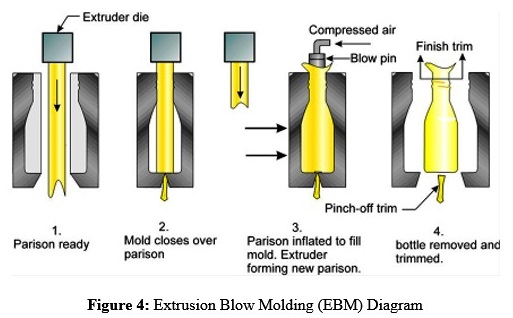
Like Extrusion Blow Molding, Injection Blow Molding also requires melted plastic and goes through a similar process. This process is more commonly used for large-quantity productions. Even though the process is similar to EBM, there is still a slight difference. This is because the parison is formed by an injection molding instead of an extruded molding. The parison is then transferred to the blow molding, where the air is injected and forces the plastic to flatten against the mold and then cooled for the plastic to keep its new shape, as seen in Figure 5.
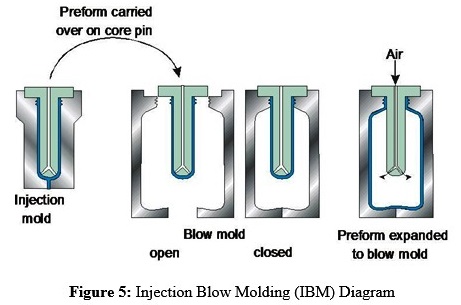
Because these two methods are similar, they are commonly used in industry to make bottles, jars, and containers. For those products, IBM is preferred over EBM because the IBM process produces superior visual and dimensional quality is ideal for both narrow and wide-mouthed containers and produces them with no flash. Another process that uses recycled metal is Blown Film Extrusion. This technology is commonly seen to make plastic films that are predominantly used in packaging. This is because molten plastic is extruded through a die and flattened to several times its diameter to get a thin film used in the Thermoforming process. Thermoforming is when a plastic film is heated to a forming temperature and formed into a specific shape. This is done by heating the plastic film in an oven and using the pressure or the force of a vacuum to stretch the plastic over a mold. Due to the simplicity of the manufacturing process, thermoforming has been known to be suitable for high-volume manufacturing. This process can be seen in Figure 6.
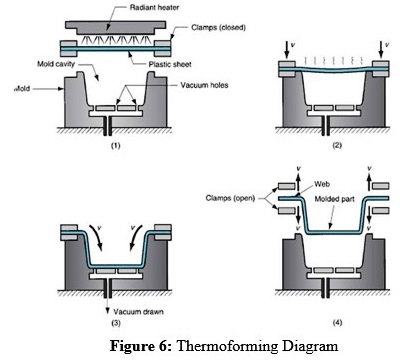
Thermoforming is seen throughout the packaging industry. It is seen in any packaging, from food to toys and tools. This is because some products need to require packaging that is molded with a specific shape so the item being packaged doesn’t get damaged over time or shipping. For Example, Figure 7 shows how a plastic film went underwent a Thermoforming process contain various tools for a brake assembly, such as brake calipers, brake pads, rotors, and necessary hardware.

After learning how recycled plastic can be reproduced into a new product, it is easy to see how recycling can benefit civilization and environmental sustainability. From all the plastics discarded into landfills, new products can be made from those transparent plastics and, which will help the environment save its natural resources and conserve energy. Unlike the cardboard recycling industry, the plastic recycling industry still has problems with developing an efficient and cost-effective method of recycling which experts say can be resolved. Another issue with recycling plastics is that some authorities cannot collect plastic waste since they do not have the resources or proper equipment.
Recycling the used packaging will help environmental sustainability and have constant material available to the manufacturers, and will help keep an efficient flow of products pushed out for daily use. This will help avoid the need to create new materials, ultimately leading to more pollution due to all the energy put into making new materials from scratch. In doing so, it will also allow for industries to develop more recent technologies that will allow for recycling and manufacturing processes to be more efficient and have the ability to recycle and reuse the materials that are currently unable to be recycled. This will, in return, lead to green packaging and a green planet.
References:
Simon. (2022, November 18). How can recycling materials lead to environmental sustainability? Sustainability Success. Retrieved December 7, 2022
10 packaging materials that are recyclable (don't discard). Bizongo. (n.d.). Retrieved December 7, 2022
“What a Waste 2.0.” Trends in Solid Waste Management, https://datatopics.worldbank.org/what-a-waste/trends_in_solid_waste_management.html.
Kate. “How Is Cardboard Recycled? - Handy Info from Boxtopia.” Boxtopia, 31 Aug. 2022, https://www.boxtopia.co.uk/blog/how-is-cardboard-recycled.
“The Complete Plastics Recycling Process.” Recycle Track Systems, 12 Oct. 2020
Compactor Management CompanyCompactor Management Company (former Northern California Compactors. “Plastic Recycling Process.” Compactor Management Company, 16 Nov. 2022, https://www.norcalcompactors.net/plastic-recycling-process/.





























